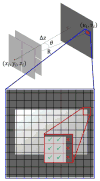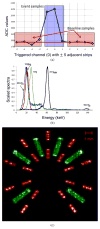High-Resolution Anamorphic SPECT Imaging
- PMID: 26160983
- PMCID: PMC4494124
- DOI: 10.1109/TNS.2014.2304853
High-Resolution Anamorphic SPECT Imaging
Abstract
We have developed a gamma-ray imaging system that combines a high-resolution silicon detector with two sets of movable, half-keel-edged copper-tungsten blades configured as crossed slits. These apertures can be positioned independently between the object and detector, producing an anamorphic image in which the axial and transaxial magnifications are not constrained to be equal. The detector is a 60 mm × 60 mm, one-millimeter-thick, one-megapixel silicon double-sided strip detector with a strip pitch of 59 μm. The flexible nature of this system allows the application of adaptive imaging techniques. We present system details; calibration, acquisition, and reconstruction methods; and imaging results.
Keywords: 103Pd; 125I; Adaptive; DSSD; SPECT; anamorphic imaging; crossed slits; double-sided strip detector; low energy; silicon; small animal.
Figures












Similar articles
-
Adaptive SPECT imaging with crossed-slit apertures.Proc SPIE Int Soc Opt Eng. 2014 Aug 17;9214:92140E. doi: 10.1117/12.2066188. Proc SPIE Int Soc Opt Eng. 2014. PMID: 26190884 Free PMC article.
-
High-resolution, anamorphic, adaptive small-animal SPECT imaging with silicon double-sided strip detectors.Proc SPIE Int Soc Opt Eng. 2011 Aug 21;8143:81430G. doi: 10.1117/12.896729. Proc SPIE Int Soc Opt Eng. 2011. PMID: 26346619 Free PMC article.
-
Thick Silicon Double-Sided Strip Detectors for Low-Energy Small-Animal SPECT.IEEE Trans Nucl Sci. 2009 Jun 1;56(3):557-564. doi: 10.1109/TNS.2009.2019106. IEEE Trans Nucl Sci. 2009. PMID: 20686626 Free PMC article.
-
A Silicon SPECT System for Molecular Imaging of the Mouse Brain.IEEE Nucl Sci Symp Conf Rec (1997). 2007 Oct-Nov;2007:2782-2784. doi: 10.1109/NSSMIC.2007.4436717. IEEE Nucl Sci Symp Conf Rec (1997). 2007. PMID: 26855557 Free PMC article.
-
Characterization of a double-sided silicon strip detector autoradiography system.Med Phys. 2015 Feb;42(2):575-84. doi: 10.1118/1.4905049. Med Phys. 2015. PMID: 25652478
Cited by
-
3D Metrology Using One Camera with Rotating Anamorphic Lenses.Sensors (Basel). 2022 Nov 1;22(21):8407. doi: 10.3390/s22218407. Sensors (Basel). 2022. PMID: 36366104 Free PMC article.
-
Adaptive SPECT imaging with crossed-slit apertures.Proc SPIE Int Soc Opt Eng. 2014 Aug 17;9214:92140E. doi: 10.1117/12.2066188. Proc SPIE Int Soc Opt Eng. 2014. PMID: 26190884 Free PMC article.
-
Molecular Imaging in the College of Optical Sciences - An Overview of Two Decades of Instrumentation Development.Proc SPIE Int Soc Opt Eng. 2014 Aug 17;9186:91860J. doi: 10.1117/12.2064808. Proc SPIE Int Soc Opt Eng. 2014. PMID: 26236069 Free PMC article.
References
-
- Abbott MB, DeClerk YA, Chen YC, Furenlid LR, Wilson DW, Stevenson GD, Whitaker MK, Woolfenden JM, Moats RA, Barrett HH. 100-micron resolution SPECT imaging of a neuroblastoma tumor model. Mol Imag. 2006;5:214.
-
- van der Have F, Vastenhouw B, Ramakers RM, Branderhorst W, Krah JO, Ji C, Staelens SG, Beekman FJ. U-SPECT-II: An ultra-high-resolution device for molecular small-animal imaging. J Nucl Med. 2009;50(4):599–605. - PubMed
-
- Schramm NU, Ebel G, Engeland U, Schurrat T, Behe M, Behr TM. High-resolution SPECT using multipinhole collimation. IEEE Trans Nucl Sci. 2003 Jun;50(3):315–320.
Grants and funding
LinkOut - more resources
Full Text Sources
Other Literature Sources
